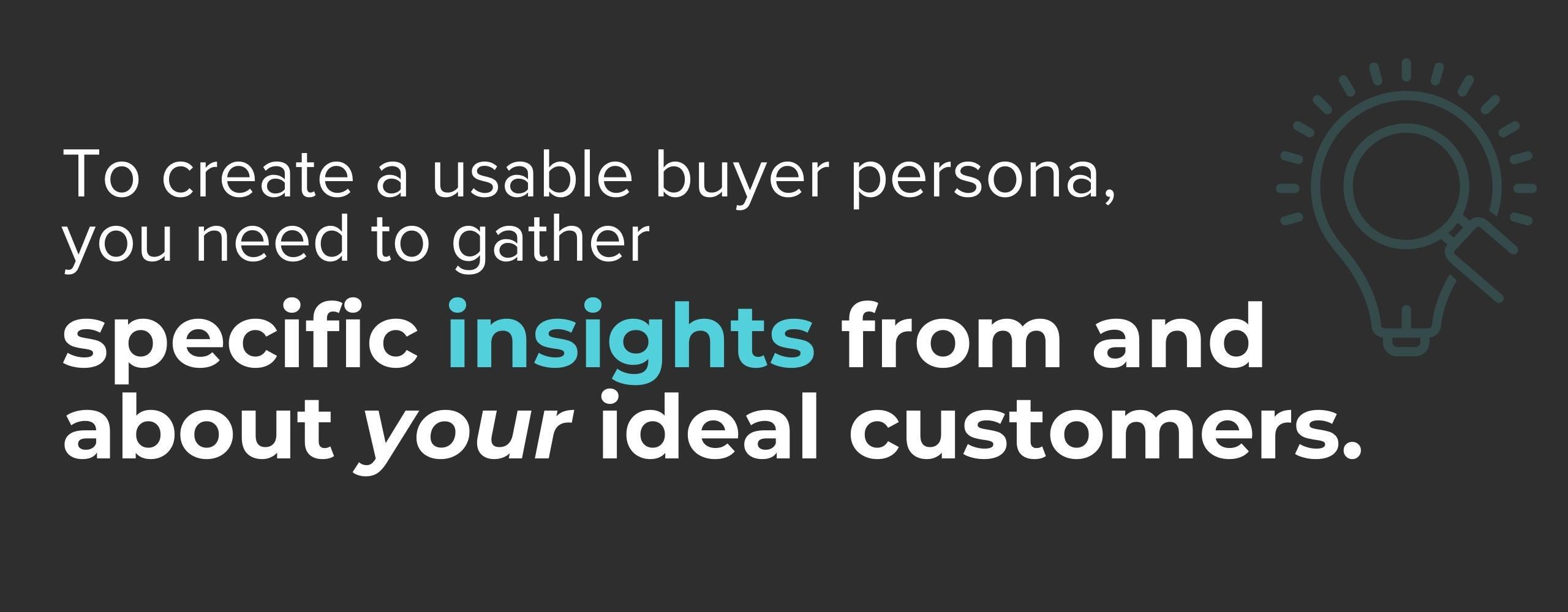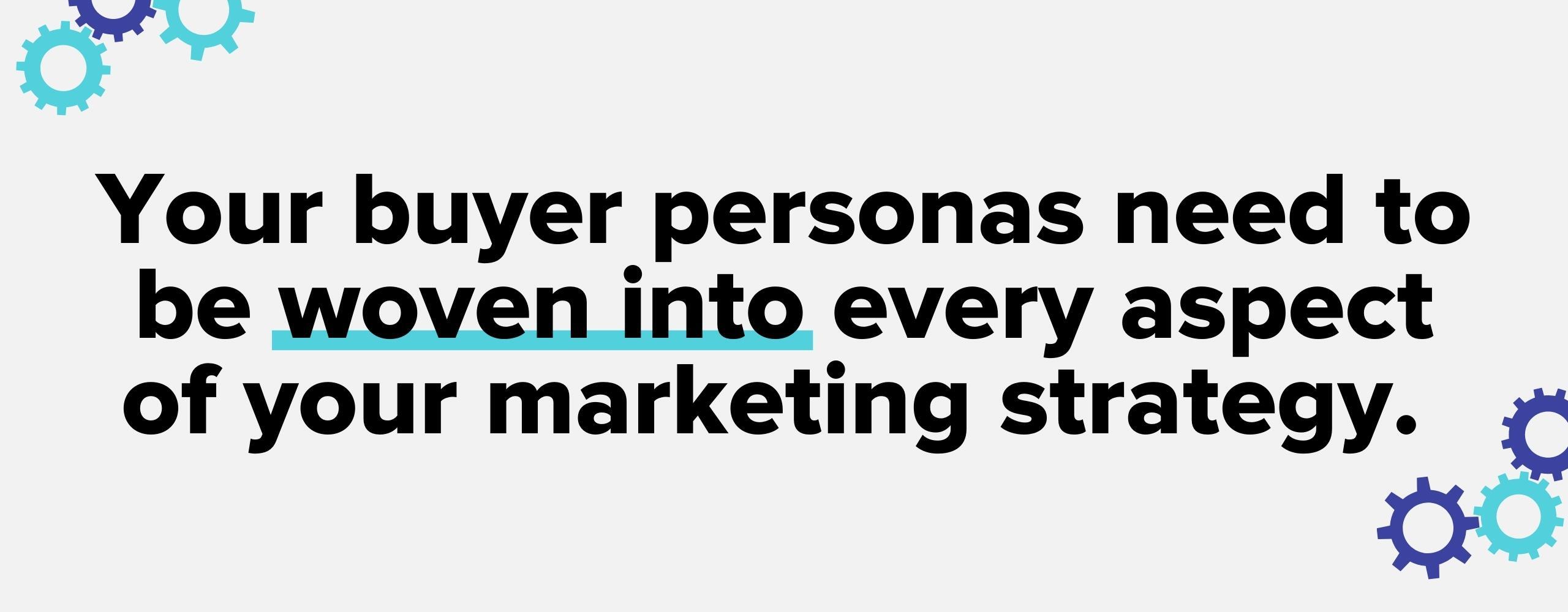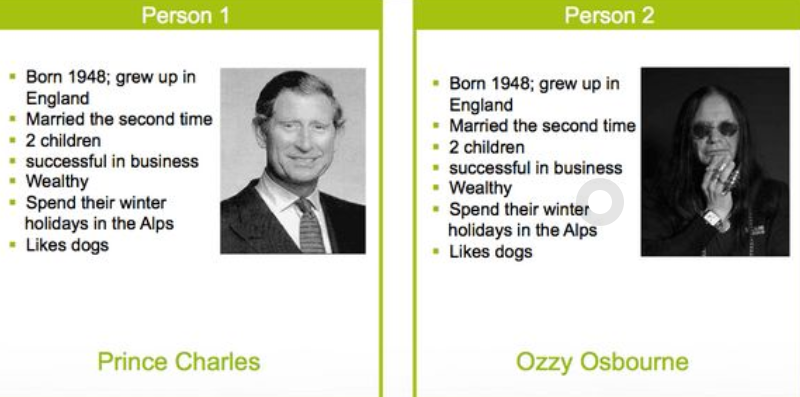Subscribe now and get the latest podcast releases delivered straight to your inbox.
Meet Michelle. 👋
Michelle is 38 years old and lives with her partner and two dogs in North Carolina. She is the Marketing Manager for a medium-sized construction company, earns $70,000 per year, and is looking for a way to increase leads and generate more revenue for the sales team in her organization.
You’ve probably seen something similar to this, either within the organization you currently work for or another.
It’s a typical, albeit brief, example of a traditional buyer persona, or a fictionalized representation of an ideal customer companies use to guide their strategy and tactics.
Buyer personas aim to pinpoint your customers' specific needs and interests to make it easier for you to create focused content and messaging and win them over.
For many years, they were seen as a lynchpin in any business strategy, but today, many marketers are debating their importance and relevance.
As a sales and marketing coach of many years, I am a firm believer that buyer personas are still extremely important, but the way most experts go about creating and implementing creating them is outdated and inefficient.
There is a better way.
What exactly is a buyer persona?
The purpose of a buyer persona is to help you understand your customers (and prospective customers) better.
Adele Ravella, author of Buyer Personas, defines a buyer persona as:
“an archetype; a composite picture of the real people who buy, or might buy, products like the ones you market, based on what you’ve learned in direct interviews with real buyers.”
Buyer personas help your entire team (from leadership to marketing and sales to customer service) focus their time on qualified prospects. This helps you ideally attract leads that will close and customers you are more likely to retain.

Buyer persona creation, in turn, is an exercise that you go through so you can not only easily identify your specific buyer in a crowded marketplace. Depending on your business, you may have as little as one or two personas — or dozens.
So, do you really need a buyer persona?
The short answer is yes, you do need a buyer persona.
You cannot succeed in sales or marketing if you don't know who you are trying to reach.
You need to understand your ideal customer better than anyone else and be willing to answer their questions in a way that no one else will. It’s the core component of They Ask, You Answer, and any strong marketing strategy.
Personas are one of the best ways to do this, but the problem is that traditional buyer personas are not always created to foster a deep understanding of your customers.
We need to change the way they are created and managed.
Why are traditional buyer personas no longer effective?
The ultimate goal of any marketing pursuit is to create a smoother, more delightful buying process that generates more leads, revenue, and profits.
However, I see organizations make four big mistakes repeatedly:
- They use generic data
- They focus solely on demographic data
- They spend too much time on research
- They "set and then forget" about their personas
Using generic data
A buyer persona is useless if it's not accurate. Unfortunately, this happens more often than you may think.

Oftentimes, organizations will develop a buyer persona using facts gleaned from online research rather than information specific to their company and product.
These reports, while interesting and useful for benchmarking, are not specific enough for you to build your strategy off of. They tend to be based on either very large or very small sample sizes that may not be reflective of your audience.
For example, general statistics may tell you that the majority of consumers want to watch a video rather than read an article, but that may no necessarily ring true for your buyers.
This leads to personas centered around high-level pain points and generalizations, not necessarily the people you work with day in and day out.
To create a usable buyer persona, you need to gather specific insights from and about your ideal customers.
You need to know who they specifically are and what makes them tick. This is the only way to create content that will truly resonate with people you actually want to work with and attract, not going off of a vague hypothesis.
Focusing solely on demographic data
Age. Location. Gender. Profession. Interests.
Yes, this demographic data might be relevant, and important to consider in terms of targeting and messaging, but they don’t necessarily tell you how and why these people buy your product or service.
Your buyer persona needs to be more nuanced and sophisticated to be useful to your team. It needs to go further than demographic data to explore the thought processes and behaviors of how people buy.
In general, we already know the way buyers make purchasing decisions has changed over the last decade.
IMPACT partner Marcus Sheridan explores this in detail in his book They Ask, You Answer, explaining how consumers have the means to be more informed than ever about their purchases.
With the world at their fingertips, the buying process has fundamentally shifted, but what does this look like for your ideal customer?
How do they actually make a buying decision? What is important for them to understand in order to become confident in that buying decision? What questions do they ask before buying?
Your buyer persona needs to take this into account.
Spending too long on research
It's easy for organizations to get caught up in a long, involved research process when it comes to creating their buyer personas.
The more data, the better right?
While in theory this sounds smart, too much time in planning and research can delay actual implementation. If you don't set a strict timeline, you even run the risk of your findings actually being outdated by the time they're documented.
"Setting and forgetting"
More often than not, once completed, buyer personas are put in a digital drawer, never to be looked at again.

They don’t get used by the marketing or sales teams and, even worse, they never get updated or evolve, even though the buyer constantly is.
If accurate and applied, a buyer persona can be a crucial component of your marketing and sales strategy. However, there is really no point in creating them if you don’t use them to inform your buying process and customer experience.
Your buyer personas need to be woven into every aspect of your marketing strategy. They should inform all of your marketing decisions and communications.
Rarely used and inaccurate buyer personas based heavily on demographics are not working as they should. The amount of time and therefore money that goes into creating these personas means they need to be relevant.
They need to help focus content and allow you to communicate effectively with your ideal client.
So how to create buyer personas the right way
Keeping in mind the four common mistakes we discussed, here's how you can go about creating buyer personas that will actually help you achieve your goals.
1. Interview your customers and those who know them best
The best way to develop an accurate buyer persona is to have marketing interview your best existing customers. These are the people who have already chosen to work with you and you not only enjoy working with, but have seen success in doing so.
Talking to this group will allow you to gather deep, first-hand insights into who your buyer truly is, what they care about, how and why they choose you, and even what may have made them have second thoughts.
Unlike researching online, you get to dig into the areas that matter most to your business. You can ask questions and draw direct conclusions rather than make assumptions based on third-party data.
It's also smart to supplement data from your buyers with some from sales and customer service teams. They work and communicate with your prospects every day and should be able to provide real-life anecdotes and feedback to further build out your persona.
In the end, when you interview your customers and those who know them best, you'll be better equipped to develop a buyer persona that is actually reflective of your ideal customer, not just a general hypothesis.
2. Go beyond demographics
Don't just home in on demographic data and assume this will be enough to effectively communicate with your ideal buyer.

Example of the danger of basing your personas purely on topical demographics (Source)
You need to focus equally on buyer behavior. Why do your customers buy, and how do they move through the buying process?
Understanding this will allow you to create a buyer persona that truly documents how and why people buy and cater to your campaigns and experiences accordingly.
According to Adele Ravella, five critical components should be included in your buyer persona, and they all relate to the how and why of your customers' buying behavior.
- Priority initiatives
- Success factors
- Perceived barriers
- Buying process
- Decision process
What goes into these buckets? I’ve broken down each of them and included sample takeaways we can draw from them.
A. Priority initiatives: List 3-5 problems your potential buyer will encounter that will help justify the purchase of your product/service.
Takeaway: We know that we need to focus on generating more of the right type of leads for our sales team.
B. Success factors: These are tangible or intangible benefits the buyer associates with success, and how your product/service will help them achieve this success.
Takeaway: Our leads and revenue will increase, and the caliber of clients that we attract will improve.
C. Perceived barriers: What factors stand in the way of your company being the chosen purchase? Why would someone not buy from us?
Takeaway: We’re more expensive than the competition and we don’t do a good job of explaining our pricing model.
D. Buying process: How does the potential customer explore and select a solution that will overcome the barriers and help them achieve success?
Takeaway: Seeking recommendations, searching online to find two or three companies that seem to be the best in the marketplace.
E. Decision criteria: What aspect of the product will the buyer assess when evaluating alternative solutions available? This should include research from buyers who choose your product and those who don’t.
Takeaway: What is the time and cost commitment as well as the potential ROI of implementing a new digital sales and marketing strategy? How long will it take?
All these components should be evaluated in-depth to ensure your ideal buyer is thoroughly understood.
This understanding is inherent to the They Ask, You Answer process. Understanding your customer better than anyone in your industry is at its core. And this model of buyer persona will help you more comprehensively explore the nuances of buyer behavior and incorporate these into your marketing plan.
In addition to these factors, ensure your personas answer the following questions:
- What specific problems do we solve for our ideal buyers?
- How, in their own words, would our buyers describe their problems?
- How do we solve these specific problems?
- In what ways does the buyer benefit from our solution?
- Why would someone NOT buy from us?
- What are the most common sales questions and objections we receive in the buying process?
- Exactly how does a good-fit buyer evaluate their options and decisions?
- In what ways do we help our buyers evaluate and make a confident decision?
- What are the most important decision-making factors for a buyer?
- What do we already know about our ideal-fit buyers who have already bought from us and enjoy working with us?
3. Test, then document
Don't spend months researching and putting together this persona and not actually marketing or selling.
We've seen companies do this, and it quickly turns into months of no actual work being done, just research that may be outdated by the time you're "done."
Take what you know about your persona from your interviews (or your assumptions) and start testing it out; see how it actually performs in the wild. Then, document what has proven true.
With this information, marketing teams can create strategically designed content to attract ideal-fit buyers, and sales teams can more easily identify ideal-fit buyers in the marketplace.
4. Review and refine
Once you've documented your buyer persona, make sure to regularly (at least annually), review and refine your personas based on any new feedback or behaviors that may have emerged since you last updated them.
Doing this will help keep your personas current and ensure your team isn't working off of old data.
A new approach to buyer personas
All in all, buyer personas remain essential to any marketing or business strategy; that is undeniable. However, if you're going to invest the time and effort into creating them, you need to do it in a way that will result in a truly valuable finished product.
- Do your own first-hand research with your existing clients and team.
- Think beyond generic demographics and seek to understand behaviors and intentions.
- Test your findings in the wild before documenting, and when you do document...
- Make sure to actually use them and update them regularly.
Your buyer personas should not be something you create and forget about, but rather a living document like your ideal customers themselves.
Use these tips to get started. If you'd like more guidance on how to put them into use to improve your content and inbound marketing, talk to one of our advisors.


Order Your Copy of Marcus Sheridan's New Book — Endless Customers!

